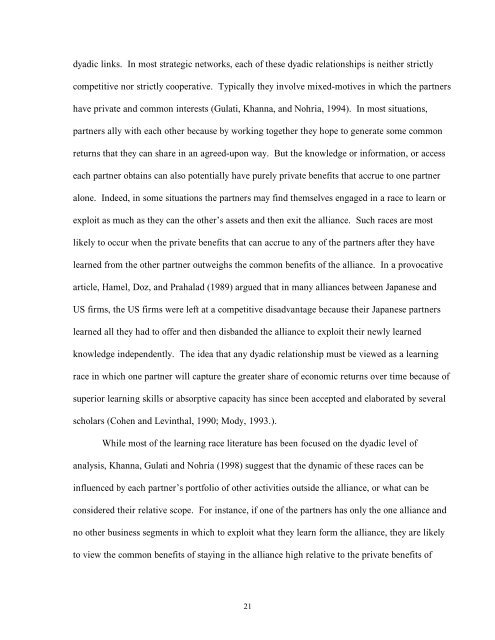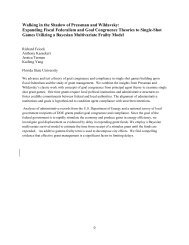STRATEGIC NETWORKS Ranjay Gulati, Nitin Nohria, Akbar Zaheer ...
STRATEGIC NETWORKS Ranjay Gulati, Nitin Nohria, Akbar Zaheer ...
STRATEGIC NETWORKS Ranjay Gulati, Nitin Nohria, Akbar Zaheer ...
You also want an ePaper? Increase the reach of your titles
YUMPU automatically turns print PDFs into web optimized ePapers that Google loves.
dyadic links. In most strategic networks, each of these dyadic relationships is neither strictlycompetitive nor strictly cooperative. Typically they involve mixed-motives in which the partnershave private and common interests (<strong>Gulati</strong>, Khanna, and <strong>Nohria</strong>, 1994). In most situations,partners ally with each other because by working together they hope to generate some commonreturns that they can share in an agreed-upon way. But the knowledge or information, or accesseach partner obtains can also potentially have purely private benefits that accrue to one partneralone. Indeed, in some situations the partners may find themselves engaged in a race to learn orexploit as much as they can the other’s assets and then exit the alliance. Such races are mostlikely to occur when the private benefits that can accrue to any of the partners after they havelearned from the other partner outweighs the common benefits of the alliance. In a provocativearticle, Hamel, Doz, and Prahalad (1989) argued that in many alliances between Japanese andUS firms, the US firms were left at a competitive disadvantage because their Japanese partnerslearned all they had to offer and then disbanded the alliance to exploit their newly learnedknowledge independently. The idea that any dyadic relationship must be viewed as a learningrace in which one partner will capture the greater share of economic returns over time because ofsuperior learning skills or absorptive capacity has since been accepted and elaborated by severalscholars (Cohen and Levinthal, 1990; Mody, 1993.).While most of the learning race literature has been focused on the dyadic level ofanalysis, Khanna, <strong>Gulati</strong> and <strong>Nohria</strong> (1998) suggest that the dynamic of these races can beinfluenced by each partner’s portfolio of other activities outside the alliance, or what can beconsidered their relative scope. For instance, if one of the partners has only the one alliance andno other business segments in which to exploit what they learn form the alliance, they are likelyto view the common benefits of staying in the alliance high relative to the private benefits of21




